"No one can solve this problem alone, but together we can change things for the better."
Are We Nearing the End of the INF Treaty?
January/February 2018
By Steven Pifer and Oliver Meier
As relations between the West and Russia deteriorate, a key Cold War arms control accord has come under threat.
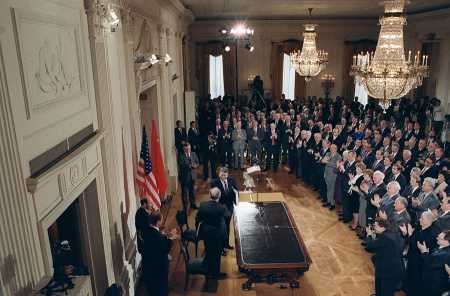 The United States charges that Russia has violated the 1987 Intermediate-Range Nuclear Forces (INF) Treaty by deploying a prohibited ground-launched cruise missile (GLCM) having a range between 500 and 5,500 kilometers. Moscow rejects the charge and instead claims that Washington has violated the agreement. The Trump administration has announced several steps in response to the Russian violation, including beginning research and development of options for U.S. intermediate-range missiles.
The United States charges that Russia has violated the 1987 Intermediate-Range Nuclear Forces (INF) Treaty by deploying a prohibited ground-launched cruise missile (GLCM) having a range between 500 and 5,500 kilometers. Moscow rejects the charge and instead claims that Washington has violated the agreement. The Trump administration has announced several steps in response to the Russian violation, including beginning research and development of options for U.S. intermediate-range missiles.
If the treaty unravels, it will open the door to an arms race in production and deployment of these missiles, which would weaken security in Europe and Asia. It would undermine support for other arms control treaties, such as the 2010 New Strategic Arms Reduction Treaty (New START) and make it difficult to reach new accords. That would not be in the interest of the United States, Russia, Europe, or Asia.
Washington and Moscow should work to preserve the INF Treaty and its benefits. If the United States and Russia desire to maintain the treaty, there are ways to resolve their compliance concerns. If they do not act to save the treaty, its days are likely numbered.
INF Treaty History
The Soviet Union began deploying the SS-20 intermediate-range ballistic missile in the late 1970s. The SS-20’s mobile launcher, three independently targetable warheads, and estimated range of 5,000 kilometers made it a significant improvement over older Soviet intermediate-range missiles and provoked alarm in Europe.
Washington at first downplayed the concern, but NATO agreed in December 1979 to the “dual-track” decision: The United States would seek to engage the Soviet Union in a negotiation aimed at reducing and limiting intermediate-range ground-launched missiles. In parallel, the U.S. military would develop and, beginning in late 1983, base GLCMs in Belgium, Italy, the Netherlands, and the United Kingdom and Pershing II ballistic missiles in Germany, provided that an arms control agreement did not obviate those deployments.
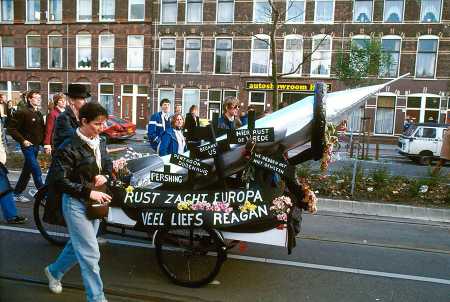 U.S.-Soviet negotiations began in 1981, and U.S. President Ronald Reagan announced the “zero-zero” proposal under which the United States would forgo its planned deployments if the Soviet Union eliminated its SS-20 and other intermediate-range missiles. Moscow rejected zero-zero, and the first two years of negotiations yielded little common ground between the sides. When the first U.S. GLCMs and Pershing IIs arrived in Europe in November 1983, the Soviets broke off the negotiations.
U.S.-Soviet negotiations began in 1981, and U.S. President Ronald Reagan announced the “zero-zero” proposal under which the United States would forgo its planned deployments if the Soviet Union eliminated its SS-20 and other intermediate-range missiles. Moscow rejected zero-zero, and the first two years of negotiations yielded little common ground between the sides. When the first U.S. GLCMs and Pershing IIs arrived in Europe in November 1983, the Soviets broke off the negotiations.
The Kremlin seemed to hope that public opposition within NATO countries would derail the U.S. missile deployments. Although it appeared a near thing at times, leaders in the five basing countries held firm despite significant domestic opposition, and the alliance moved forward with deployment. In 1985 the Soviets agreed to resume negotiations.
The negotiations made progress in 1986-1987 along the lines of the zero-zero proposal. Reagan and his Soviet counterpart, Mikhail Gorbachev, signed the INF Treaty on December 8, 1987. The treaty banned the production, flight-testing, and possession of all ground-based cruise and ballistic missiles having ranges between 500 and 5,500 kilometers (300 and 3,300 miles) and required the elimination of all such existing missiles. When the treaty’s reduction period concluded in 1991, the United States and Soviet Union had destroyed some 2,700 missiles, as well as launchers and other support equipment.
Following the Soviet Union’s collapse at the end of 1991, Russia and several other post-Soviet states assumed the Soviet INF Treaty obligations. The treaty’s inspection period ended in 2001. The Special Verification Commission (SVC), established by the treaty as a venue for discussing the treaty’s implementation and compliance concerns, with the participation of the United States, Russia, Belarus, Kazakhstan, and Ukraine, had its last meeting in 2003 before a 13-year hiatus.
In 2005, Russian officials expressed interest in withdrawing from the treaty and suggested to the United States to jointly terminate the accord. Washington refused. In February 2007, Russian President Vladimir Putin expressed concern that, although the United States and Russia were banned from having intermediate-range missiles, third countries were developing and fielding such systems, and those countries tended to be in close proximity to Russia.
The following October, Putin proposed making the INF Treaty “global in scope.” The United States and Russia at the UN General Assembly jointly called on third countries to eliminate their intermediate-range missile systems. Moscow did not seriously pursue its proposal, although Russian officials continued to express concern about the proliferation of intermediate-range missiles.
Treaty Violation Charges
During the Obama administration, reports began to circulate that Russia was violating the INF Treaty. In July 2014, the U.S. government publicly charged that Russia had violated the accord. Washington offered few public details, but press reports indicated that Russia had tested a prohibited intermediate-range GLCM. The INF Treaty does not ban development per se, but draws the line at testing. In March 2017, a senior U.S. military officer said Russia had begun to deploy the missile, confirming press reports that had appeared two months earlier.
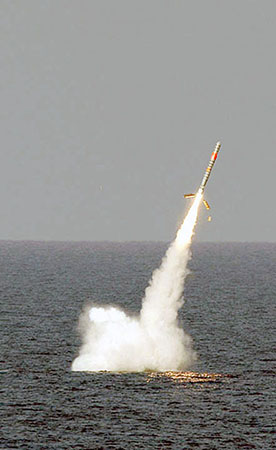 U.S. government officials have made little information available publicly on the specifics of the Russian violation. This stems from their desire to protect sources and methods, that is, how the U.S. government learned of the violation. They have been consulting with allies on INF Treaty questions and the Russian violation.
U.S. government officials have made little information available publicly on the specifics of the Russian violation. This stems from their desire to protect sources and methods, that is, how the U.S. government learned of the violation. They have been consulting with allies on INF Treaty questions and the Russian violation.
The Trump administration says the Russian system of concern is the SSC-8 GLCM, which the U.S. government says uses the Russian designator 9M729. This missile appears to be an extended-range version of the SSC-7 (Iskander-K) cruise missile. The Iskander-K is an INF Treaty-permitted cruise missile with a range of less than 500 kilometers. The SSC-8/9M729 reportedly uses a launcher that differs from the Iskander-K launcher. Deployment of SSC-8 missiles is expected in all four Russian military districts, that is, in the European and Asian parts of Russia.
Russia has denied the U.S. charge and asserted that U.S. officials had not produced enough information for it to identify the system of concern. U.S. officials flatly rejected that, saying that Moscow has all the information it needs. The U.S. Department of State’s 2017 compliance report notes that, during several meetings, the U.S. side provided “more than enough information for the Russian side to identify the missile in question,” including “[i]nformation pertaining to the missile and the launcher,” such as “Russia’s internal designator for the mobile launcher chassis and the names of the companies involved in developing and producing the missile and launcher,” as well as data on “the violating GLCM’s test history, including coordinates of the tests and Russia’s attempts to obfuscate the nature of the program.”1 Russian officials recently acknowledged that the 9M729 (SSC-8) is the missile in question, but they maintain that it is fully compliant with the INF Treaty.
Russian officials charge the United States with violating the INF Treaty. The primary Russian concern appears to center on the Mk-41 vertical launch system for the Standard Missile-3 (SM-3) interceptors in Romania, soon to be deployed in Poland, which are part of NATO’s missile defense program. Russian officials note that Mk-41 vertical launch systems on U.S. Navy warships can launch sea-launched cruise missiles, which are quite similar to the now eliminated GLCMs, as well as SM-3 interceptors and other missiles, and say that the launchers in Romania and Poland can contain cruise missiles.
Moreover, the Russians charge that the United States uses intermediate-range ballistic missiles as targets in missile defense tests and operates armed unmanned aerial vehicles (UAVs, or drones) that are equivalent to GLCMs of intermediate range.
U.S. and Russian officials discussed the charges in political channels for several years before convening the SVC in November 2016. The commission met again in mid-December 2017. Thus far, it has not reported progress toward resolving the compliance questions.
Resolving Compliance Issues
From a technical perspective, parties to the INF Treaty could resolve these concerns through a combination of political-level talks and technical exchanges in the SVC. A group of nongovernmental experts, the
trilateral Deep Cuts Commission, has developed a number of proposals on how the SVC could tackle these noncompliance concerns.2
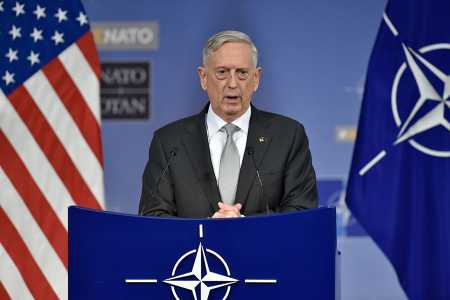 If Moscow were prepared to address the U.S. charge seriously, the SVC could agree on procedures under which the Russian side would exhibit the SSC-8 and its launcher to U.S. experts and explain the missile’s characteristics, particularly its range. If that exhibition satisfied the U.S. side that the missile was consistent with the INF Treaty, the matter would be put to rest. If there were further questions, they could be discussed in the SVC. Another option for addressing the problem would be to create a new panel of technical experts from the United States and Russia to discuss ways to resolve noncompliance concerns.
If Moscow were prepared to address the U.S. charge seriously, the SVC could agree on procedures under which the Russian side would exhibit the SSC-8 and its launcher to U.S. experts and explain the missile’s characteristics, particularly its range. If that exhibition satisfied the U.S. side that the missile was consistent with the INF Treaty, the matter would be put to rest. If there were further questions, they could be discussed in the SVC. Another option for addressing the problem would be to create a new panel of technical experts from the United States and Russia to discuss ways to resolve noncompliance concerns.
If it turned out that the SSC-8 had a range in excess of 500 kilometers but not in excess of 5,500 kilometers, the issue would be more difficult to resolve. All missiles and their associated launchers, including all launchers from which the missile was tested, would have to be eliminated in a verifiable manner in order for Russia to return to compliance with the treaty. The INF Treaty contains precise verification procedures, but they were developed and tailored to certify the destruction of U.S. and Soviet systems in existence as of 1987. Those procedures would require adaptation for the SSC-8 and its launcher, which could be agreed in the SVC. In any case, the sooner that detailed discussions on the violation commenced, the easier it would be to find solutions to tackle the compliance problems raised by Washington and Moscow.
With regard to the Russian charges, the dispute over the U.S. use of booster stages in target missiles for ballistic missile defense tests should not prove difficult to resolve. The INF Treaty makes an allowance for such missiles, and the sides’ technical experts could work out language in the SVC to distinguish between prohibited intermediate-range ground-launched ballistic missiles and allowed target missiles for missile defense tests. In addition, they might agree on language restricting target missiles to production facilities and sites associated with missile defense tests.
The second dispute regards whether armed UAVs, which the United States deploys and Russia is developing, are covered by the agreement. Armed UAVs did not exist when the United States and Soviet Union concluded the INF Treaty. UAVs differ from cruise missiles because they can return to base after their mission is completed. This clear distinction between GLCMs and UAVs should enable experts in the SVC to agree on language to clarify the scope of the INF Treaty.
The more serious Russian charge concerns the Mk-41 vertical launch system deployed in Romania and scheduled to become operational in Poland in 2018. Experts could address that in two ways. One would be modification of the land-based Mk-41 system with an observable difference—ideally, a functionally related observable difference—to distinguish the launchers in Romania and Poland from Mk-41 vertical launch systems on U.S. warships.
The second approach would employ transparency measures to reassure Russia that the launchers in Romania and Poland did not contain cruise missiles or weapons other than SM-3 interceptors. With the agreement of NATO and, in particular, Romania and Poland, U.S. officials could invite Russian inspectors to periodically visit the SM-3 sites, where they could randomly choose two or some other agreed number of the 24 launch tubes in the vertical launch system to be opened, allowing confirmation that they contained SM-3 interceptors.
The SVC would work out procedures for such inspections, as well as the particulars for observable differences for the vertical launch systems in Romania and Poland. Given the concerns of NATO member states, it might make sense to include European experts on visits to the SM-3 interceptor sites or to any Russian exhibition of the SSC-8.
The Politics of Compliance
The political obstacles to resolving the INF Treaty issues appear more difficult to overcome than the technical hurdles. The INF Treaty dispute happens at a time when a number of other arms control and transparency agreements, including the Open Skies Treaty, are increasingly affected by the crisis in U.S.-Russian relations. These accords may lack the strong supporting constituencies in Moscow, Washington, and, to some degree, Europe that they used to have.
A number of Russian military and civilian officials seem to favor withdrawal from the INF Treaty. They argue that it is a Cold War relic that has been overtaken by technological advances. These include the deployment of U.S. missile defenses in Europe and the growing number of intermediate-range missiles in the inventories of third countries. China, for example, deploys hundreds of intermediate-range ballistic and cruise missiles. North Korea, South Korea, India, Pakistan, Iran, Saudi Arabia, and Israel also possess intermediate-range missiles.
Those Russians who support continued adherence to the treaty worry about a new arms race and the prospect of the deployment of new U.S. precision-guided weapons systems in Europe. Moscow’s official position remains that it has not violated the treaty and remains committed to it. Russian Foreign Minister Sergey Lavrov has said that Russia remains willing “to discuss the concerns of both parties.”3
U.S. Attempts to Bring Russia Back Into Compliance
While charging Russia with violating the INF Treaty, the Obama administration made clear its interest in maintaining the treaty and sought to bring Russia back into compliance. It failed. The Trump administration conducted a review of the agreement while senior administration officials spoke in the fall of 2017 of looking for leverage to bring Russia back into compliance with the accord.
Also at that time, Congress agreed on language in the National Defense Authorization Act that authorizes up to $58 million to respond to the alleged Russian INF Treaty violation, including by the establishment of a program of record to develop an intermediate-range GLCM.4
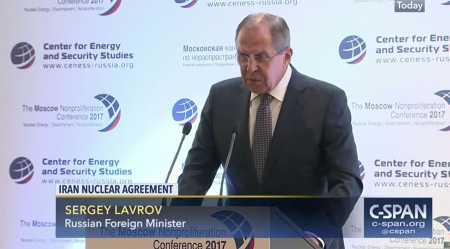 On December 8, 2017—the 30th anniversary of the signing of the INF Treaty—the Trump administration announced what it called an integrated strategy for dealing with the Russian violation. The strategy reaffirmed the U.S. commitment to preserving the treaty and said the United States would (1) continue efforts to seek a diplomatic settlement of the Russian violation, including through the SVC; (2) begin research and development on options for conventionally armed intermediate-range ground-launched missile systems; and (3) impose economic sanctions on Russian entities that had taken part in development and production of the SSC-8.
On December 8, 2017—the 30th anniversary of the signing of the INF Treaty—the Trump administration announced what it called an integrated strategy for dealing with the Russian violation. The strategy reaffirmed the U.S. commitment to preserving the treaty and said the United States would (1) continue efforts to seek a diplomatic settlement of the Russian violation, including through the SVC; (2) begin research and development on options for conventionally armed intermediate-range ground-launched missile systems; and (3) impose economic sanctions on Russian entities that had taken part in development and production of the SSC-8.
Development of a new U.S. intermediate-range ground-launched missile, although not a violation of the treaty as long as the United States did not proceed to flight-testing, would be at odds with the purpose of the INF Treaty. After all, it was negotiated with the goal of eliminating all land-based intermediate-range missiles from Europe and globally. The Russians undoubtedly will attempt to exploit the contradiction between U.S. words and actions if Washington were to pursue development of a new intermediate-range ground-launched missile while insisting on the value of a prohibition of those weapons.
The push for a tough response is based on the hope that the United States and NATO can pressure Russia to come back into compliance. Congress, which distrusts the Trump administration’s Russia policy, may also hope to make sure that the president does not paper over the INF Treaty issue. Proponents of a tit-for-tat response recall that deploying GLCMs and Pershing IIs in the early 1980s helped to trigger a discussion in Moscow that eventually led to the agreement to eliminate all INF Treaty-covered missiles.
Could a second dual-track decision, including a decision to deploy new U.S. intermediate-range systems in Europe, push Moscow back to the negotiating table? A number of factors appear to lower the likelihood that such a policy would work. First, finding consensus within NATO for such a course would prove difficult. In the mid-1980s, the Soviet Union’s military position relative to NATO was significantly stronger than that of Russia today relative to NATO. Second, the relationship between Moscow and Washington 30 years ago was on an upward trajectory, whereas today U.S.-Russian relations are in a downward spiral. Arguably, the leaderships in Moscow and Washington in the 1980s were pursuing more consistent and predictable policies and were more interested in reversing the nuclear arms race than their successors are today.
Moreover, a program that moved beyond early research and development to flight-testing and production of a new U.S. intermediate-range ground-launched missile would cost billions of dollars at a time when the Department of Defense budget already faces major shortfalls. Fielding a new missile system would take years and not provide a timely response to Russia’s current violation.
The Alliance Dimension
The U.S. and NATO military responses to Russian deployment of a new GLCM should primarily aim at reassuring allies. Although allies may not object to U.S. development of a new intermediate-range ground-launched missile, proceeding to flight-testing and deployment would severely stress NATO solidarity.
Deploying U.S. conventionally armed air- and sea-launched cruise missiles to Europe would offer an alternative action. Temporary deployments of conventional B-1 heavy bombers combined with Joint Air-to-Surface Standoff Missiles, as well as more frequent deployments to northern European waters of U.S. warships and submarines carrying conventionally armed sea-launched cruise missiles, could also signal the U.S. commitment to Europe. Deployment of the USS Georgia or USS Florida—converted Ohio-class submarines that carry up to 154 sea-launched cruise missiles—to seas near Europe would also underscore that any attempt by Moscow to create zones of different security are not going to be successful.
Steps such as these would be easier, faster, and cheaper than building a new ground-launched missile. They might affect Moscow’s calculation and encourage the Kremlin to return to compliance with the INF Treaty. If Russia did so, these steps would be readily reversible.
Such moves are also less likely to provoke a crisis within the alliance about its response to Russia’s actions. It is by no means certain that NATO would agree to deploy U.S. missiles now, as it did in its 1979 decision. The development of new intermediate-range ground-launched missiles will inevitably bring back memories of contentious debates within NATO about moving forward with the deployment of GLCMs and Pershing IIs in the early 1980s.
NATO members favor maintaining the INF Treaty. The communiqué of the 2016 NATO Warsaw summit termed preservation of the agreement “crucial to Euro-Atlantic security” and called on Moscow “to preserve the viability of the INF Treaty through ensuring full and verifiable compliance.”5
At a November 2017 NATO defense ministers meeting, U.S. Secretary of Defense Jim Mattis again briefed allies on Russia’s alleged INF Treaty violation. Mattis reportedly urged allies to craft a joint position to force Russia back into compliance by the time of the next NATO summit in July 2018, suggesting that Washington would otherwise react unilaterally.6
On December 15, NATO allies took note of the U.S. decision to begin development of a new GLCM but stopped short of collectively endorsing it by stating that “our actions, including national measures taken by some allies, seek to preserve the INF Treaty, strengthen the alliance, and incentivize Russia to engage in good faith.” NATO also stated that “allies have identified a Russian missile system that raises serious concerns,” yet allies did not jointly affirm the U.S. finding of Russian non-compliance.7
That silence frustrates U.S. officials, particularly because a Russian intermediate-range GLCM would be designed and built to strike targets in Europe and Asia, not the United States. To improve alliance cohesion, Washington should inform the alliance in more specific detail about its intelligence on the SSC-8. It should consult with allies on the way forward. Any attempt to force allies to support U.S. military deployments could well increase skepticism in Europe about the reliability of Washington’s nuclear policies under President Donald Trump.
Given that Congress has become a driving force behind the U.S. push to respond in kind to Russia’s policies, a parliamentary dialogue on how to respond to the INF Treaty violation would be important. NATO’s Parliamentary Assembly, which regularly brings together legislators from alliance members, might be a good place to have discussions about a response to Russia’s actions. This could be complemented by bilateral dialogues between parliamentarians.
Any division among allies on how to act on the INF Treaty question would play into Moscow’s hands. In any event, it would make no sense for Washington to withdraw from the treaty unless it can present compelling evidence of Russia’s violation. Absent such information, the United States likely would get the blame for the treaty’s end, and Russia would be free to deploy intermediate-range missiles without any treaty constraints.
Conclusion
The INF Treaty is fundamental to European security and important to the security of U.S. allies and others in Asia. The treaty’s collapse would open the way for an arms race in intermediate-range ground-launched missiles, with unpredictable strategic and political consequences for relations between the West and Russia.8 It would also weaken the U.S.-Russian nuclear arms control regime. Indeed, although their proposal did not survive congressional conference committee negotiations on the National Defense Authorization Act, some Republicans had proposed to deny funds for extension of New START beyond 2021 if Russia was not in compliance with the INF Treaty.
The INF Treaty has made a significant contribution to security in Europe and Asia over the past 30 years. It should be preserved. That will require smart decisions by the Trump administration and concerted action with NATO members, which will otherwise find they are confronting a new Russian missile threat.
Saving the INF Treaty will also require a change in the Kremlin’s current course. The West should do what it can to encourage such a change.
ENDNOTES
1 Bureau of Arms Control, Verification and Compliance, U.S. Department of State, “2017 Adherence to and Compliance With Arms Control, Nonproliferation, and Disarmament Agreements and Commitments,” April 2017, pp. 13-14, http://www.state.gov/documents/organization/270603.pdf.
2 See Hans Kristensen et al., “Preserving the INF Treaty: A Special Briefing Paper,” April 24, 2017, http://deepcuts.org/files/pdf/Special_Brief_-_Deep_Cuts_INF.pdf. For information on the Deep Cuts Commission, see http://deepcuts.org/.
3 Ministry of Foreign Affairs of the Russian Federation, “Foreign Minister Sergey Lavrov’s Remarks and Answers to Media Questions at the Moscow Nonproliferation Conference,” October 20, 2017, http://www.mid.ru/en/press_service/minister_speeches/-/asset_publisher/7OvQR5KJWVmR/content/id/2913751.
4 Center for Arms Control and Non-Proliferation, “Analysis of Fiscal Year 2018 National Defense Authorization Bill: HR 2810,” n.d., https://armscontrolcenter.org/wp-content/uploads/2017/11/NDAA-conference-analysis-111417.pdf.
5 “Warsaw Summit Communiqué,” NATO press release no. (2016) 100, July 9, 2016, para. 62, https://www.nato.int/cps/en/natohq/official_texts_133169.htm.
6 Matthias Gebauer, Christoph Schult, and Klaus Wiegrefe, “Alleged INF Treaty Violation; U.S. Demands NATO Action on Russian Missiles,” Spiegel Online, December 8, 2017, http://www.spiegel.de/international/world/us-delivers-ultimatum-to-nato-regarding-russian-missiles-a-1182426.html.
7 North Atlantic Treaty Organization, “Statement by the North Atlantic Council on the Intermediate-Range Nuclear Forces (INF) Treaty,” NATO Press Release (2017) 180, December 15, 2017, https://www.nato.int/cps/en/natohq/news_150016.htm.
8 For example, see Ian Anthony, “European Security After the INF Treaty,” Survival, Vol. 59, No. 6 (December 2014-January 2018): 61-76.
Steven Pifer is a nonresident senior fellow with the Brookings Institution. Oliver Meier is deputy head of the International Security Research Division at the German Institute for International and Security Affairs. Both are members of the Deep Cuts Commission, a nongovernmental group of German, Russian and U.S. experts.
